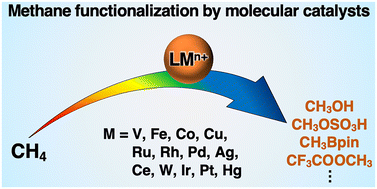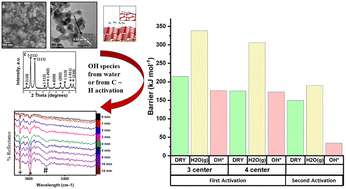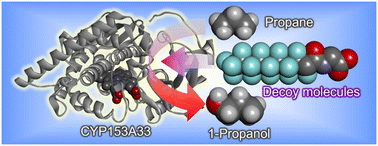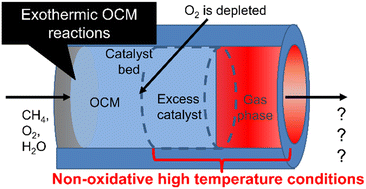Themed collection Integrated approaches for methane activation

Introduction to integrated approaches for methane activation
Kenichi Shimizu, Wataru Ueda & Hua Song introduce the Catalysis Science & Technology themed collection on Integrated approaches for methane activation.

Catal. Sci. Technol., 2024,14, 2972-2972
https://doi.org/10.1039/D4CY90039A
Zeolite-based catalysts for oxidative upgrading of methane: design and control of active sites
Various reported active sites in zeolite-based catalysts categorized into three groups in terms of their origin have been overviewed from the viewpoints of their performance, structure, and catalysis.

Catal. Sci. Technol., 2023,13, 4020-4044
https://doi.org/10.1039/D3CY00482A
Functionalization of methane using molecular metal complexes as catalysts
Efficient and selective functionalization of methane is one of the most important tasks in chemistry in light of its utilization as a naturally abundant feedstock toward the development of a sustainable society.

Catal. Sci. Technol., 2023,13, 4270-4284
https://doi.org/10.1039/D3CY00647F
Methane monooxygenases; physiology, biochemistry and structure
Methane monooxygenases (MMOs) are potential biocatalysts for industrial methanol production from methane. We summarize recent structural and biochemical studies of pMMO and discuss the future directions to develop efficient and robust biocatalysts.

Catal. Sci. Technol., 2023,13, 6342-6354
https://doi.org/10.1039/D3CY00737E
Photocatalytic conversion of carbon dioxide, methane, and air for green fuels synthesis
Green fuels are derived from renewable resources that can replace or reduce the use of fossil fuels, and they can help reduce carbon emissions and dependence on finite resources including oil and natural gas.

Catal. Sci. Technol., 2023,13, 4895-4918
https://doi.org/10.1039/D3CY00675A
Selective conversion of methane to ethane and hydrogen over In/molecular-sieve-3A catalyst
The molecular-sieve-3A material functioned as a good support for the indium liquid metal catalyst for the dehydrogenative conversion of methane (DCM) to ethane, ethylene, and H2 with 100% selectivity at 873 K.

Catal. Sci. Technol., 2023,13, 6712-6717
https://doi.org/10.1039/D3CY01217D
Insights into the role of water and surface OH species in methane activation on copper oxide: a combined theoretical and experimental study
An integrated theoretical and experimental investigation reveals how the presence of water alters the activity of metal oxide catalysts in gas-phase activation and conversion of methane.

Catal. Sci. Technol., 2023,13, 6764-6779
https://doi.org/10.1039/D3CY00431G
Low temperature reforming of methane with CO2 over Pt/CeO2, Ni/CeO2 and Pt–Ni/CeO2 catalysts prepared by a solution-combustion method
This study investigates the low temperature reforming of methane with CO2 over mono-metallic (Pt/CeO2 and Ni/CeO2) and bi-metallic (Pt–Ni/CeO2) solid solution catalysts prepared by using a one-pot solution-combustion method.

Catal. Sci. Technol., 2023,13, 6431-6445
https://doi.org/10.1039/D3CY00600J
Highly selective hydroxylation of gaseous alkanes at the terminal position by wild-type CYP153A33
Highly regioselective hydroxylation of propane at the terminal position has been achieved using CYP153A33 with decoy molecules. This combination can exhibit the ability to hydroxylate ethane and methane.

Catal. Sci. Technol., 2023,13, 6146-6152
https://doi.org/10.1039/D3CY00752A
Direct methylation of benzene with methane over Co/MFI catalysts generated by self-dispersion of Co(OH)2
A methane–benzene reaction was performed over Co/MFI prepared with an aqueous solution of Co(OAc)2 and MFI zeolite.

Catal. Sci. Technol., 2023,13, 5969-5977
https://doi.org/10.1039/D3CY00305A
Mechanistic studies on catalytic alkane oxidation by Murahashi's O2/copper(II)/aldehyde system
Catalytic alkane hydroxylation by Murahashi's O2/copper(II)/aldehyde system was revisited to obtain mechanistic details of the catalytic cycle including the reactive oxidant as well as the role of the copper catalyst.

Catal. Sci. Technol., 2023,13, 5859-5867
https://doi.org/10.1039/D3CY00944K
c-Axis-oriented sheet-like Cu/AEI zeolite contributes to continuous direct oxidation of methane to methanol
The cubic and sheet-like AEI zeolites were prepared in the absence and presence of CTAB. Sheet-like Cu/AEI zeolite exhibited more stable and higher methanol formation rate than the cubic-shaped one due to the shortened straight channel length.

Catal. Sci. Technol., 2023,13, 5831-5841
https://doi.org/10.1039/D3CY00584D
The selective oxidation of methane to methanol using in situ generated H2O2 over palladium-based bimetallic catalysts
The selective oxidation of methane to methanol, using in situ generated H2O2 has been investigated using a series of TS-1 supported palladium-based catalysts, with the introduction of Au or Ni considerably improving catalytic performance.

Catal. Sci. Technol., 2023,13, 5848-5858
https://doi.org/10.1039/D3CY00116D
Oxidative coupling of methane under microwave: core–shell catalysts for selective C2 production and homogeneous temperature control
The oxidative coupling of methane (OCM) was investigated using a catalyst with a core@shell structure or a physical mixture comprised of MgO and SiC or Fe3O4, which was thermally activated via conventional resistive heating or microwave heating.

Catal. Sci. Technol., 2023,13, 5757-5766
https://doi.org/10.1039/D3CY00606A
Indirect design of OCM catalysts through machine learning of catalyst surface oxygen species
Catalysts for oxidative coupling of methane (OCM) were designed through machine learning of a property of surface oxygen species on the basis of the knowledge that catalytic performance for the OCM is affected by catalyst surface oxygen species.

Catal. Sci. Technol., 2023,13, 5576-5581
https://doi.org/10.1039/D3CY00587A
Tuning catalytic activity with steric and electron-withdrawing effects of a porphyrin substituent
The reactivity, spectroscopic, and kinetic studies of the catalytic reactions showed that the catalytic activity is determined by the balance of the rates of the formation, reaction, and decomposition reactions of the reactive intermediate.

Catal. Sci. Technol., 2023,13, 5280-5289
https://doi.org/10.1039/D3CY00758H
Co-activation of methane and nitrogen to acetonitrile over MoCx/Al2O3 catalysts
Methane and nitrogen were co-activated by MoCx/Al2O3 catalysts to produce acetonitrile.

Catal. Sci. Technol., 2023,13, 5248-5258
https://doi.org/10.1039/D3CY00585B
Bismuth phosphate nanoparticle catalyst for direct oxidation of methane into formaldehyde
Monoclinic BiPO4 nanoparticles selectively gave HCHO for the direct oxidation of CH4 thorough the possible involvement of surface active oxygen species on BiPO4 in the activation of CH4.

Catal. Sci. Technol., 2023,13, 5180-5189
https://doi.org/10.1039/D3CY00590A
Mordenite-stabilised rhenium catalyst for partial oxidation of methane to syngas
A proton-type mordenite facilitates the reduction of hepta-valent Re species. The reduced Re species show a good catalytic activity toward the direct partial oxidation of CH4 to CO and subsequent reforming reactions.

Catal. Sci. Technol., 2023,13, 5190-5196
https://doi.org/10.1039/D3CY00077J
Insights into Pt–CN species on an alumina-supported platinum catalyst as active intermediates or inhibitors for low-temperature hydrogen cyanide synthesis from methane and nitric oxide
In situ measurements revealed that the Pt–CN species function not only as intermediates but also as inhibitors for low-temperature HCN synthesis.

Catal. Sci. Technol., 2023,13, 5017-5024
https://doi.org/10.1039/D3CY00581J
Oxygenase mimicking immobilised iron complex catalysts for alkane hydroxylation with H2O2
Immobilised iron complex catalysts with hydrophobic reaction fields mimicking the active sites of enzymes constructed into the mesopores of SBA-15. Surface modification with a longer fluoroalkyl chain and Me3Si group improves catalytic activity.

Catal. Sci. Technol., 2023,13, 4839-4846
https://doi.org/10.1039/D3CY00698K
Role of polyoxometalate precursors and supports in the selective oxidation of methane into formaldehyde using supported metal oxide subnanocluster catalysts
By examining various metal-containing polyoxometalate (POM) precursors and supports, it was found that catalysts prepared using Fe-containing POM precursors supported on SiO2 with a high specific surface area were effective for CH4 oxidation.

Catal. Sci. Technol., 2023,13, 4744-4752
https://doi.org/10.1039/D3CY00750B
Preparation of BCYF0.10–YDC/BCYF0.10–Ni dual-layer hollow fiber membrane for dry reforming of methane and hydrogen purification
A ceramic hydrogen permeable membrane reactor for dry reforming of methane (DRM) enables both the reaction and separation processes to be carried out simultaneously, producing synthesis gas and pure hydrogen while mitigating greenhouse gas emissions.

Catal. Sci. Technol., 2023,13, 4673-4683
https://doi.org/10.1039/D3CY00595J
Non-thermal plasma assisted non-oxidative methane liquefaction for fuel production at near ambient conditions
The non-thermal plasma could effectively convert pure methane into gasoline-range hydrocarbons with limited coke formation over the SBA-15 catalyst.

Catal. Sci. Technol., 2023,13, 4665-4672
https://doi.org/10.1039/D3CY00835E
Photoelectrochemical C–H activation of methane to methyl radical at room temperature
Visible light illumination induced CH4 oxidation over a WO3 photoanode. The production of C2H6 implies the formation of methyl radicals through photoelectrochemical activation of methane.

Catal. Sci. Technol., 2023,13, 4640-4645
https://doi.org/10.1039/D3CY00632H
Dehydrogenative coupling of methane over Pt/Al2O3 catalysts: effect of hydrogen co-feeding
Pt/AI2O3 converts CH4 into C2 hydrocarbons by H2 co-feeding.

Catal. Sci. Technol., 2023,13, 4656-4664
https://doi.org/10.1039/D3CY00612C
Leveraging machine learning engineering to uncover insights into heterogeneous catalyst design for oxidative coupling of methane
Unveiling current issues in the investigation of highly-active heterogeneous catalysts using machine learning engineering techniques was discussed in the case of oxidative coupling of methane with support vector regression and Bayesian optimization.

Catal. Sci. Technol., 2023,13, 4646-4655
https://doi.org/10.1039/D3CY00596H
Enhanced coke-resistant Co-modified Ni/modified alumina catalyst for the bireforming of methane
Biogas has been highlighted as a renewable energy and local source for syngas production via reforming techniques to combat global warming effects and energy sustainability.

Catal. Sci. Technol., 2023,13, 4506-4516
https://doi.org/10.1039/D3CY00425B
Active and durable copper phosphate catalysts modified with metal oxides for methane oxidation with oxygen into formaldehyde
Copper phosphates as active catalysts for methane oxidation with O2 into formaldehyde were deposited on silica supports or dispersed with aluminum oxides in order to enhance their catalytic performance.

Catal. Sci. Technol., 2023,13, 3859-3866
https://doi.org/10.1039/D3CY00573A
Methane activation with nitric oxide at low temperatures on supported Pt catalysts: effects of the support
Pt supported on various metal oxides was examined for the activation of CH4 with NO at low temperatures and atmospheric pressure.

Catal. Sci. Technol., 2023,13, 3927-3939
https://doi.org/10.1039/D3CY00555K
Consequence of products from oxidative coupling of methane in a non-oxidative high temperature environment
Oxidative coupling of methane (OCM) is an exothermic reaction that results in the temperature rise towards the latter part of the reactor. This study reports the consequence of OCM product distribution after O2 depletion at high temperatures.

Catal. Sci. Technol., 2023,13, 2142-2150
https://doi.org/10.1039/D2CY02145E
Evaluation of CH4 oxidation activity of high-valent iron-oxo species of a μ-nitrido-bridged heterodimer of iron porphycene and iron phthalocyanine
Catalytic CH4 oxidation activity of a μ-nitrido-bridged heterodimer of an iron phthalocyanine and an iron porphycene in an aqueous solution containing excess H2O2 was examined.

Catal. Sci. Technol., 2023,13, 1725-1734
https://doi.org/10.1039/D2CY01980A
About this collection
This special collection of CS&T, Guest Edited by Kenichi Shimizu (Hokkaido University, Japan), Wataru Ueda (Kanagawa University, Japan) and Hua Song (University of Calgary, Canada) showcases recent prominent achievements within the field of catalytic methane conversion for promoting next-stage research worldwide. The developments of catalytic science and technologies in relation to methane utilization have long been difficult challenges, and nowadays the achievements of various catalytic methane conversion technologies are under increasing demand with the advent of carbon-neutral policies. In the last decade, various new catalytic routes and pathways for methane conversion, such as oxidation of methane to methanol, have been progressed remarkably. To respond to this, various research projects specifically dedicated to catalytic methane conversion have been conducted and have yielded innovative catalysts for methane conversion.